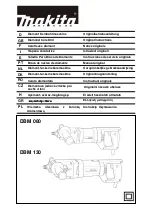
Page of 15
11
DRILLING IN WOOD, COMPOSITE MATERIALS AND PLASTICS
Although most “twist” drill bits are designed for drilling into metal, they are the most common bit used
for boring holes in wood, wood composites and plastics. There are many types of drill bits available
that may be more appropriate or designed specifically for boring the type of hole you desire.
Additional drill bits to choose from include: spade bits, brad bits, self-feed bits, hole saws, circle
cutters, multi-spur bits and fastener bits, to name just a few! Woodworking publications and tool
supply store personnel are good sources to help you select the drill bit that best satisfies your needs.
With the tool unplugged from its power source
• Install the appropriate bit into the chuck and tighten the chuck.
• Place the forward/reverse switch in the forward position.
• Mark the location(s) on the work piece where the holes are to be drilled.
• Secure the work piece with clamps or other means.
• Wear safety goggles or safety glasses with side shields. Wear a dust mask or respirator to
prevent inhalation of wood dust.
To drill the hole
• Plug the tool into the power source.
• Place tip of the drill bit on the work piece where the hole is being drilled.
• Apply downward pressure and slowly depress the switch trigger.
• When using a twist drill, withdraw the bit from the hole frequently to clear built-up wood chips from
the flutes. Clearing the flutes avoids overheating the bit and burning the wood.
• When drilling plastics, use slower speeds to avoid melting the material.
• Reduce pressure on the drill just before the bit breaks through the work piece to avoid splintering
the wood. (Note: Clamping a backing block to the work piece will keep the back of the wood from
splintering. If not using a backing block when using spade bits and hole saws, reduce pressure as
soon as the bit point breaks through the work piece and complete drilling the hole from the
opposite side.)
DRILLING IN METAL
Important Note
: Use good quality high-speed steel twist drill bits.
• With the drill unplugged, install the bit and perform the pre-drilling checks as stated in the
preceding wood drilling section.
• To make starting the hole easier and keep the bit from “walking” on the work piece, use a center
punch to make a small impression in the metal. Place the drill bit tip into the impression and start
the drill by slowly depressing the switch trigger. Apply only enough pressure to keep the bit cutting
into the metal.
WARNING
:
DO NOT FORCE the tool. Too much pressure may cause bits to break,
resulting in bodily injury. Excessive pressure will cause bits to overheat, damaging the drill

































